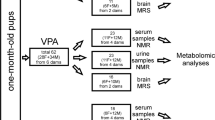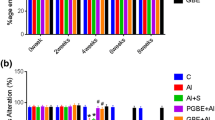Abstract
Search for indicators of neurodegenerative disorders is a hot topic where much research remains to be done. Our aim was to determine proton nuclear magnetic resonance (1H-NMR) spectra of brain metabolites in the trimethyltin (TMT) model of neurodegeneration. Male Wistar rats were subjected to TMT or saline and were sacrificed on day 3 or 24 after administration. 1H-NMR spectrum was measured on the 600 MHz Varian VNMRS spectrometer in nano-probe in the volume of 40 μl of hippocampal extracts. TMT administration resulted in reduction of the hippocampal weight on day 24. Of the sixteen identified metabolite spectra, decreased aspartate and increased glutamine contents were observed in the initial asymptomatic stage of neurodegeneration on day 3 in hippocampal extracts of TMT exposed rats compared to sham animals. Increased myo-inositol content was observed on day 24. The presented data provide further knowledge about this experimental model and putative indicators of neuronal damage.



Similar content being viewed by others
References
Neha Sodhi RK, Jaggi AS, Singh N (2014) Animal models of dementia and cognitive dysfunction. Life Sci 109:73–86. doi:10.1016/j.lfs.2014.05.017
Koczyk D (1996) How does trimethylthin affect the brain: facts and hypotheses. Acta Neurobiol Exp 56:587–596
Geloso MC, Corvino V, Michetti F (2011) Trimethyltin-induced hippocampal degeneration as a tool to investigate neurodegenerative processes. Neurochem Int 58:729–738. doi:10.1016/j.neuint.2011.03.009
Gasparova Z, Janega P, Stara V, Ujhazy E (2012) Early and late stage of neurodegeneration induced by trimethyltin in hippocampus and cortex of male Wistar rats. Neuro Endocrinol Lett 33:689–696
Ross BD, Bluml S, Cowan R, Danielsen E, Farrow N, Gruetter R (1997) In vivo magnetic resonance spectroscopy of human brain: the biophysical basis of dementia. Biophys Chem 68:161–172. doi:10.1016/s0301-4622(97)00032-x
Govindaraju V, Young K, Maudsley AA (2000) Proton NMR chemical shifts and coupling constants for brain metabolites. NMR Biomed 13:129–153. doi:10.1002/1099-1492(200005)13:3<129::aid-nbm619>3.3.co;2-m
Shin EJ, Suh SK, Lim YK, Jhoo WK, Hjelle OP, Ottersen OP, Shin CY, Ko KH, Kim WK, Kim DS, Chun W, Ali S, Kim HC (2005) Ascorbate attenuates trimethyltin-induced oxidative burden and neuronal degeneration in the rat hippocampus by maintaining glutathione homeostasis. Neuroscience 133:715–727. doi:10.1016/j.neuroscience.2005.02.030
McPherson CA, Merrick BA, Harry GJ (2014) In vivo molecular markers for pro-inflammatory cytokine M1 stage and resident microglia in trimethyltin-induced hippocampal injury. Neurotox Res 25:45–56. doi:10.1007/s12640-013-9422-3
Figiel I, Dzwonek K (2007) TNFα and TNF receptor 1 expression in the mixed neuronal-glia cultures of hippocampal dentate gyrus exposed to glutamate or trimethyltin. Brain Res 1131:17–28. doi:10.1016/j.brainres.2006.10.095
Brock TO, O’Callaghan JP (1987) Quantitative changes in the synaptic vesicle proteins synapsin I and p38 and the astrocyte-specific protein glial fibrillary acidic protein are associated with chemical-induced injury to the rat central nervous system. J Neurosci 4:931–942
Whittington DL, Woodruff ML, Baisden RH (1989) The time-course of trimethyltin-induced fiber and terminal degeneration in hippocampus. Neurotoxicol Teratol 11:21–33. doi:10.1016/0892-0362(89)90081-0
Macri MA, D’Alessandro N, Di Giulio C, Di Iorio P, Di Luzio S, Giuliani P, Bianchi G, Esposito E (2006) Regional changes in metabolite profile after long-term hypoxia-ischemia in brains of young and aged rats: a quantitative proton MRS study. Neurobiol Aging 27:98–104. doi:10.1016/j.neurobiolaging.2005.01.007
Gasparova Z, Stara V, Janega P, Navarova J, Sedlackova N, Mach M, Ujhazy E (2014) Pyridoindole antioxidant-induced preservation of rat hippocampal pyramidal cell number linked with reduction of oxidative stress yet without influence on cognitive deterioration in Alzheimer-like neurodegeneration. Neuro Endocrinol Lett 35:454–462
Bobinski M, Wegiel J, Wisniewski HM, Tarnawski M, Bobinski M, Reisberg B, De Leon MJ, Miller DC (1996) Neurofibrillary pathology—correlation with hippocampal formation atrophy in Alzheimer disease. Neurobiol Aging 17:909–919. doi:10.1016/s0197-4580(96)00160-1
Double K, Halliday G, Kril J, Harasty J, Cullen K, Brooks W, Creasey H, Broe G (1996) Topography of brain atrophy during normal aging and Alzheimer’s disease. Neurobiol Aging 17:513–521. doi:10.1016/s0197-4580(96)00005-x
Kril JJ, Patel S, Harding AJ, Halliday GM (2002) Neuron loss from the hippocampus of Alzheimer’s disease exceeds extracellular neurofibrillary tangle formation. Acta Neuropathol 103:370–376. doi:10.1007/s00401-001-0477-5
Kril JJ, Hodges J, Halliday G (2004) Relationship between hippocampal volume and CA1 neuron loss in brains of humans with and without Alzheimer’s disease. Neurosci Lett 361:9–12. doi:10.1016/j.neulet.2004.02.001
Simic G, Kostovic I, Winblad B, Bogdanovic N (1997) Volume and number of neurons of the human hippocampal formation in normal aging and Alzheimer’s disease. J Comp Neurol 379:482–494. doi:10.1002/(sici)1096-9861(19970324)379:4<482::aid-cne2>3.0.co;2-z
West MJ, Coleman PD, Flood DG, Troncoso JC (1994) Differences in the pattern of hippocampal neuronal loss in normal ageing and Alzheimer’s disease. Lancet 344:769–772. doi:10.1016/S0140-6736(94)92338-8
D’Aniello S, Somorjai I, Garcia-Fernàndez J, Topo E, D’Aniello A (2011) d-Aspartic acid is a novel endogenous neurotransmitter. FASEB J 25:1014–1027. doi:10.1096/fj.10-168492
Errico F, Nisticò R, Palma G, Federici M, Affuso A, Brilli E, Topo E, Centonze D, Bernardi G, Bozzi Y, D’Aniello A, Di Lauro R, Mercuri NB, Usiello A (2008) Increased levels of d-aspartate in the hippocampus enhance LTP but do not facilitate cognitive flexibility. Mol Cell Neurosci 37:236–246. doi:10.1016/j.mcn.2007.09.012
Errico F, Nistico R, Napoletano F, Mazzola C, Astone D, Pisapia T, Giustizieri M, D’Aniello A, Mercuri NB, Usiello A (2011) Increased d-aspartate brain content rescues hippocampal age-related synaptic plasticity deterioration of mice. Neurobiol Aging 32:2229–2243. doi:10.1016/j.neurobiolaging.2010.01.002
Topo E, Soricelli A, Di Maio A, D’Aniello E, Di Fiore MM, D’Aniello A (2010) Evidence for the involvement of d-aspartic acid in learning and memory of rat. Amino Acids 38:1561–1569. doi:10.1007/s00726-009-0369-x
Liu Y, Zhang J (2000) Recent development in NMDA receptors. Chin Med J (Engl) 10:948–956
Petrović M, Horák M, Sedláček M, Vyklický L Jr (2005) Physiology and pathology of NMDA receptors. Prague Med Rep 106:113–136
Walton HS, Dodd PR (2007) Glutamate–glutamine cycling in Alzheimer’s disease. Neurochem Int 50:1052–1066. doi:10.1016/j.neuint.2006.10.007
Haris M, Cai K, Singh A, Hariharan H, Reddy R (2011) In vivo mapping of brain myo-inositol. Neuroimage 54:2079–2085. doi:10.1016/j.neuroimage.2010.10.017
Lin Y, Yao J, Chen Y, Pang L, Li H, Cao Z, You K, Dai H, Wu R (2014) Hippocampal neurochemical changes in senescent mice induced with chronic injection of d-galactose and NaNO2: an in vitro high-resolution NMR spectroscopy study at 9.4 T. PLoS One 9(2):e88562. doi:10.1371/journal.pone.0088562
Miller BL, Moats RA, Shonk T, Ernst T, Woolley S, Ross BD (1993) Alzheimer disease: depiction of increased cerebral myo-inositol with proton MR spectroscopy. Radiology 187:433–437. doi:10.1148/radiology.187.2.8475286
Huang W, Alexander GE, Chang L, Shetty HU, Krasuski JS, Rapoport SI, Schapiro MB (2001) Brain metabolite concentration and dementia severity in Alzheimer’s disease: a 1H-MRS study. Neurology 57:626–632. doi:10.1212/wnl.57.4.626
Pfefferbaum A, Adalsteinsson A, Spielman D, Sullivan EV, Lim KO (1999) In vivo brain concentrations of N-acetyl compounds, creatinine and chlorine in Alzheimer’s disease. Arch Gen Psychiatry 56:185–192. doi:10.1001/archpsyc.56.2.185
Adalsteinsson E, Sullivan EV, Kleinhans N, Spielman DM, Pfefferbaum A (2000) Longitudinal decline of the neuronal marker N-acetyl aspartate in Alzheimer’s disease. Lancet 355:1696–1697. doi:10.1016/S0140-6736(00)02246-7
Reyngoudt H, Claeys T, Vlerick L, Verleden S, Acou M, Deblaere K, De Deene Y, Audenaert K, Goethals I, Achten E (2012) Age-related differences in metabolites in the posterior cingulate cortex and hippocampus of normal aging brain: a (1)H-MRS study. Eur J Radiol 81:223–231. doi:10.1016/j.ejrad.2011.01.106
Zhang X, Liu H, Wu J, Zhang X, Liu M, Wang Y (2009) Metabonomic alterations in hippocampus, temporal and prefrontal cortex with age in rats. Neurochem Int 54:481–487. doi:10.1016/j.neuint.2009.02.004
Paban V, Fauvelle F, Alescio-Lautier B (2010) Age-related changes in metabolic profiles of rat hippocampus and cortices. Eur J Neurosci 31:1063–1073. doi:10.1111/j.1460-9568.2010.07126.x
Gasparova Z, Janega P, Pronayova N, Liptaj T (2012) Middle-aged rat hippocampus and some early changes accompanying aging. Cent Eur J Biol 7:810–816. doi:10.2478/s11535-012-0074-8
Acknowledgments
The study was supported by the Slovak Grant Agency for Science VEGA 2/0054/15. The authors thank to Mrs. Julia Polakova for her technical assistance.
Author information
Authors and Affiliations
Corresponding author
Ethics declarations
Conflict of interest
The authors declare that there are no conflicts of interest.
Ethical Approval
All procedures involving animals were performed in compliance with the Principles of Laboratory Animal Care issued by the Ethical Committee of the Institute of Experimental Pharmacology and Toxicology, Slovak Academy of Sciences of Slovakia and by the State Veterinary and Food Administration of Slovakia. The welfare of animals used for research was respected.
Rights and permissions
About this article
Cite this article
Gasparova, Z., Pronayova, N., Stara, V. et al. In Vitro Metabolomic Approach to Hippocampal Neurodegeneration Induced by Trimethyltin. Neurochem Res 41, 715–721 (2016). https://doi.org/10.1007/s11064-015-1740-9
Received:
Revised:
Accepted:
Published:
Issue Date:
DOI: https://doi.org/10.1007/s11064-015-1740-9




